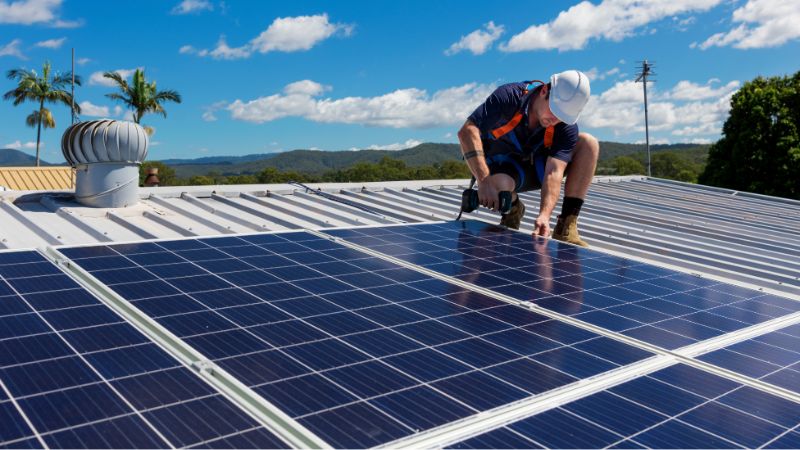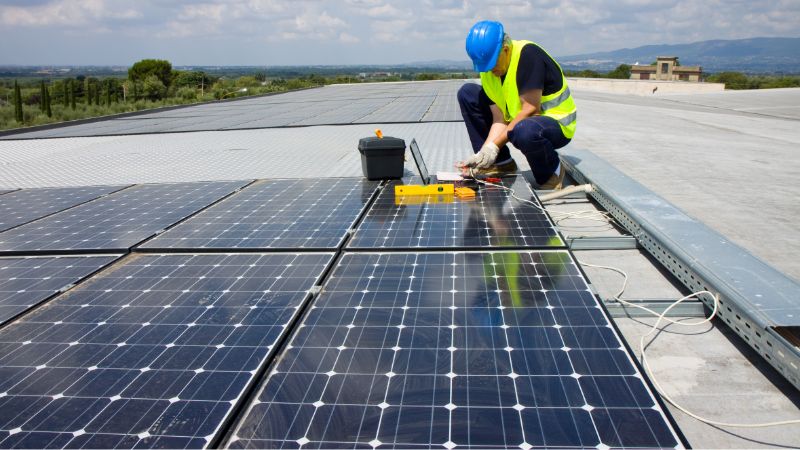The move toward sustainable energy has made solar panels an attractive option for many homeowners. While sloped roofs are common for solar installations, flat roofs offer unique advantages that make them excellent candidates for solar energy systems.
Let’s explore what you need to know about installing solar panels on your flat roof.

What to Consider before Installing Solar Panels?
1. Assessing Your Flat Roof for Solar Panel Installation
Before proceeding with installation, your roof needs a thorough evaluation. Key factors to consider include:
- Roof age and condition
- Structural integrity
- Current waterproofing system
- Weight-bearing capacity
- Available unobstructed space
2. Understanding Roof Pitch and Its Impact on Solar Panels
While called “flat,” these roofs typically have a slight pitch of 1-10 degrees for water drainage. This minimal slope rarely affects solar panel installation but helps determine the best mounting approach and panel orientation. Professional installers will factor this into their design to maintain proper drainage.
3. Working with Qualified Solar Panel Installers
The success of your solar installation largely depends on choosing the right professionals. Look for installers who demonstrate current licenses and certifications, specific experience with flat roof installations, and comprehensive knowledge of local building requirements. A strong warranty program and positive track record are essential indicators of reliable service.
How to Install Solar Panels on a Flat Roof?
1. Steps for Flat Roof Solar Panel Installation
The installation process begins with a thorough assessment of your roof’s structural integrity. Professional installers will evaluate your roof’s load-bearing capacity and determine the most suitable layout for your solar array. This crucial planning phase ensures both safety and optimal system performance.
The installation process typically follows these key stages:
- Structural assessment and system design
- Mounting system installation
- Panel placement and electrical connections
- Final testing and commissioning
2. Choosing the Right Mounting System
The three main options available are ballasted systems, mechanically attached systems, and hybrid solutions. Each has its advantages, and the choice depends on factors such as roof structure, local weather conditions, and building codes.
Ballasted systems use weight to secure panels without penetrating the roof membrane, making them popular for commercial installations. Mechanically attached systems offer maximum security but require roof penetrations, while hybrid systems combine both approaches for optimal stability.
3. Common Mistakes to Avoid
One frequent mistake is underestimating the importance of weight distribution. Your solar array must be properly balanced to prevent stress on any particular part of the roof structure. Similarly, you should maintain proper drainage paths – panels and mounting systems should never impede water flow, as this could lead to roof damage over time.
Proper spacing between panels is also important, not just for maintenance access but also for optimal airflow. This consideration often gets overlooked in the quest to maximize panel density, but it’s crucial for long-term system performance and maintenance.

What Are the Advantages of Solar Panels on Flat Roofs?
1. Design Flexibility and Optimization
Flat roofs provide remarkable flexibility in panel orientation. Unlike sloped roofs that have a fixed angle, flat roof installations allow you to position panels at the optimal angle for maximum sun exposure. This flexibility can significantly improve your system’s efficiency and energy production.
Additionally, flat roofs provide practical benefits that make them ideal for solar installations:
- Easy access for installation and maintenance
- Greater freedom in panel arrangement
- Minimal visual impact from street level
- Better options for future system expansion
2. Cost-Effectiveness
Flat roof installations often prove more economical than their sloped counterparts. The accessibility of flat roofs typically results in lower labor costs during installation, as workers can move more freely and safely. Installation teams can complete the work more efficiently, reducing the overall project timeline and associated costs.
The financial benefits extend beyond initial installation costs. Flat roofs allow for:
- Optimal space utilization for maximum power generation
- Reduced mounting hardware requirements in many cases
- More straightforward maintenance procedures
3. Enhanced Energy Efficiency
Flat roofs create unique opportunities for maximizing solar energy production. The ability to adjust panel tilt angles to match your geographical location means optimal performance throughout the year. Additionally, flat roof installations can incorporate proper ventilation design, helping maintain ideal operating temperatures for better system performance and longevity.
What Are the Best Practices for Flat Roof Solar Installation?
The success of your solar installation largely depends on following industry best practices. This begins with proper planning and extends through installation to ongoing maintenance.
1. Using Ballast to Secure Solar Panels on Flat Roofs
Ballast mounting systems are often the preferred choice for flat roofs because they don’t require roof penetration. The system uses weight blocks to secure the panels against wind uplift. Your installer will calculate the exact ballast weight needed based on:
- Local wind conditions
- Building height
- Roof edge distance
- Panel dimensions
- Local building codes
2. Maintaining Your Solar Panel System for Optimal Performance
Regular maintenance ensures your solar system operates at peak efficiency. A well-maintained system should include:
- Quarterly visual inspections
- Annual professional maintenance checks
- Regular panel cleaning to remove debris
- Monitoring system performance through your inverter
- Immediate attention to any performance issues

How Do Solar Panels for Flat Roofs Compare to Pitched Roofs?
1. Installation Differences
The installation process differs significantly between flat and pitched roofs. Flat roof installations offer several unique advantages. Installation teams can work more safely and efficiently on a level surface, often completing projects more quickly than on pitched roofs. The mounting systems are also fundamentally different – while pitched roofs typically use rail systems attached directly to the roof structure, flat roofs can utilize non-penetrating ballasted systems.
2. Performance Comparison
Both roof types can achieve excellent results when properly designed. However, they each have distinct characteristics:
Flat Roof Advantages:
- Customizable panel angles for optimal sun exposure
- Easier access for maintenance and cleaning
- More flexible panel layout options
- Better options for bilateral solar panels
Sloped Roof Advantages:
- Natural angle may be optimal for solar collection
- Built-in drainage system
- Generally requires less additional hardware
- Often has existing structural suppor
What Are the Costs Associated with Flat Roof Solar Installation?
1. Breaking Down the Costs of Solar Panel Installation on a Flat Roof
The total cost of a flat roof solar installation typically includes several components. Solar panels range from $200-$400 per panel, while mounting systems cost $2-$4 per watt. Inverter systems generally run between $1,000-$2,500, and labor costs average $0.50-$1.50 per watt. Additional expenses include permits and inspections, typically ranging from $500-$1,000.
2. Long-Term Savings of Installing Solar Panels
Solar installation represents a significant upfront investment, but the long-term benefits are substantial. Most homeowners see a 20-30% reduction in electricity costs, and the current federal tax incentive (26% of system cost as of 2024) helps offset initial expenses. Many states offer additional incentives, and solar installations typically increase property value, with return on investment realized within 5-10 years.
Can Solar Panels Be Installed on Any Flat Roof?
Not all flat roofs are suitable for solar panels. The roof must meet certain criteria:
- The structure must support the additional weight of the solar system (typically 2-4 pounds per square foot).
- The roof membrane should be in good condition and have at least 10 years of life remaining.
- There should be sufficient unshaded space for the desired system size.
What Is the Expected Lifespan of Solar Panels on a Flat Roof?
Modern solar panels are built to last, with a typical lifespan of 25-30 years. Manufacturer warranties usually cover 25 years, providing peace of mind for your investment. The actual longevity of your system depends on installation quality, environmental conditions, regular maintenance, and component quality.
While panels will continue to produce electricity after 25-30 years, their efficiency typically decreases by about 0.5-1% annually. Most systems will still generate at 75-80% of their original capacity after 25 years.

Installing solar panels on a flat roof can be an excellent investment for homeowners looking to embrace renewable energy. While the initial considerations and costs may seem daunting, the long-term benefits often outweigh the challenges. With proper planning and execution, your flat roof solar system can be a valuable addition to your home, providing both environmental and financial benefits.
Partner with Deyeess for Expert Solar Solutions on Flat Roofs
Choosing the right equipment can maximize the performance and longevity of your solar panel system. For a reliable and efficient solution, consider exploring products and services offered by Deyeess.
Deyeess is a leading global provider specializing in solar inverter and energy storage systems designed for sustainable living. We are committed to delivering innovative solutions that maximize efficiency and meet the unique needs of flat roof installations.
Our extensive range of products includes both high-voltage and low-voltage series, allowing for customized configurations that enhance energy production and savings. Contact us today and make an inquiry for more information.